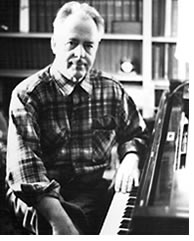About
In Memoriam: Henry Eltinge Breed Jr.,
Dec 08, 2007
OSA Mourns the Loss of Henry Eltinge Breed Jr.
 Henry Eltinge Breed Jr., an OSA Fellow Emeritus, physics professor and expert in photography, electro-optics and acoustics, died on December 8, 2007. He was 92 years old.
Henry Eltinge Breed Jr., an OSA Fellow Emeritus, physics professor and expert in photography, electro-optics and acoustics, died on December 8, 2007. He was 92 years old.
Breed was born in Manhattan on December 5, 1915, the son of the actress and activist Ethel Burns and the civil engineer H. Eltinge Breed. He attended Storm King School in Cornwall, N.Y., and earned his undergraduate degree in physics from Colgate University. He began his professional life as a photographer, assisting Berenice Abbott in 1937-1938 as she worked on her landmark WPA (Work Progress Administration) photographic study of New York City, titled Changing New York. He also ran his own studio in Manhattan, specializing in portraiture.
Raised a Quaker and a pacifist, he registered as a conscientious objector when World War II broke out. But in late 1942, having piloted airplanes since his youth, he enlisted as a flight instructor in the Navy as the prospects of the war worsened. He served in that capacity
with distinction through the remainder of the war.
After the war, he earned an M.S. in astrophysics from Harvard and a Ph.D. in physics from Rensselaer Polytechnic Institute. He specialized in both optics and acoustics, on which he wrote, taught and consulted widely. Although he worked principally as a professor of physics, he also developed electro-optical navigation equipment and communications systems for NASA’s Apollo lunar missions and for the U.S. Navy. The Navy used these systems to help find and save vessels lost at sea.
While a professor at Rensselaer Polytechnic Institute, Breed simultaneously carried out research in acoustics, audio engineering and physical optics. In the field of audio engineering, he was on the cutting edge of work in psychoacoustics and binaural recording. He was also engaged in the analysis of stereophonic, triphonic and quadraphonic sound reproduction. His work in sound localization looked to the future, toward present day investigations into ambisonics.
Breed’s research in acoustics focused on the architectural scale modeling of concert halls and the role of microphone choice and placement in the analysis of a hall’s acoustical signature. A number of his studies were directed toward understanding and quantifying the sonic characteristics of concert halls and performance spaces using full-scale architectural models. Breed’s input was sought when engineers were looking to make acoustical improvements to Avery Fisher Hall at Lincoln Center. In the 1980s, he authored a comparative study on the acoustics of a number of major European concert halls.
His passion for teaching and making science accessible to the non-scientist led to his developing courses geared toward non-scientists. These included a course in the optics of photography, as well as a laboratory course tailored to architecture majors, which led to regular presentations at meetings of the American Association of Physics Teachers. Breed twice won Fulbright Fellowships to lecture and research in these areas abroad, in both Norway and Peru.
Elected a fellow of the Optical Society of America, he was also a member of a many other professional societies, on a number of whose boards he served.
When not working, Breed was a competitive racing sailor who earned numerous prizes. In fact, he was depicted by Grandma Moses in her 1955 painting, Sailing. He was also a championship fencer, and he greatly enjoyed skiing, hiking and gardening. Breed is survived by two sons: Henry Eltinge Breed III of Manhattan and Joseph Illick Breed of Tokyo.
— Henry Breed III and James Mastracco
